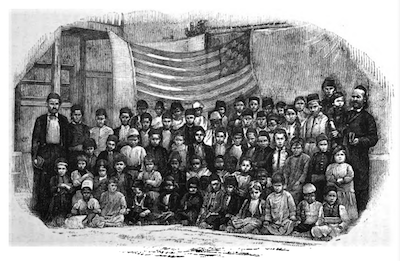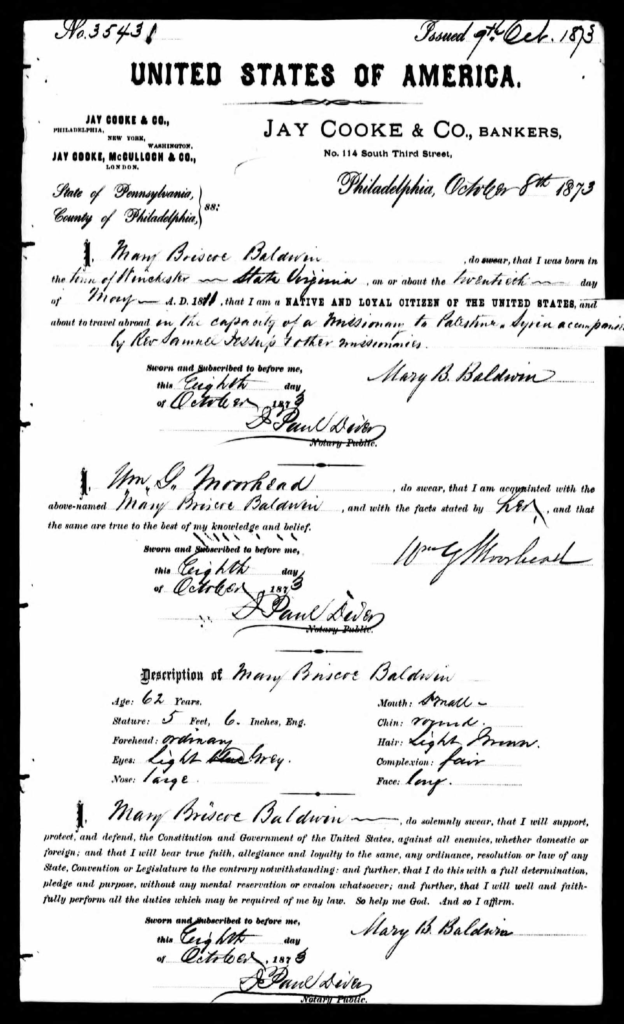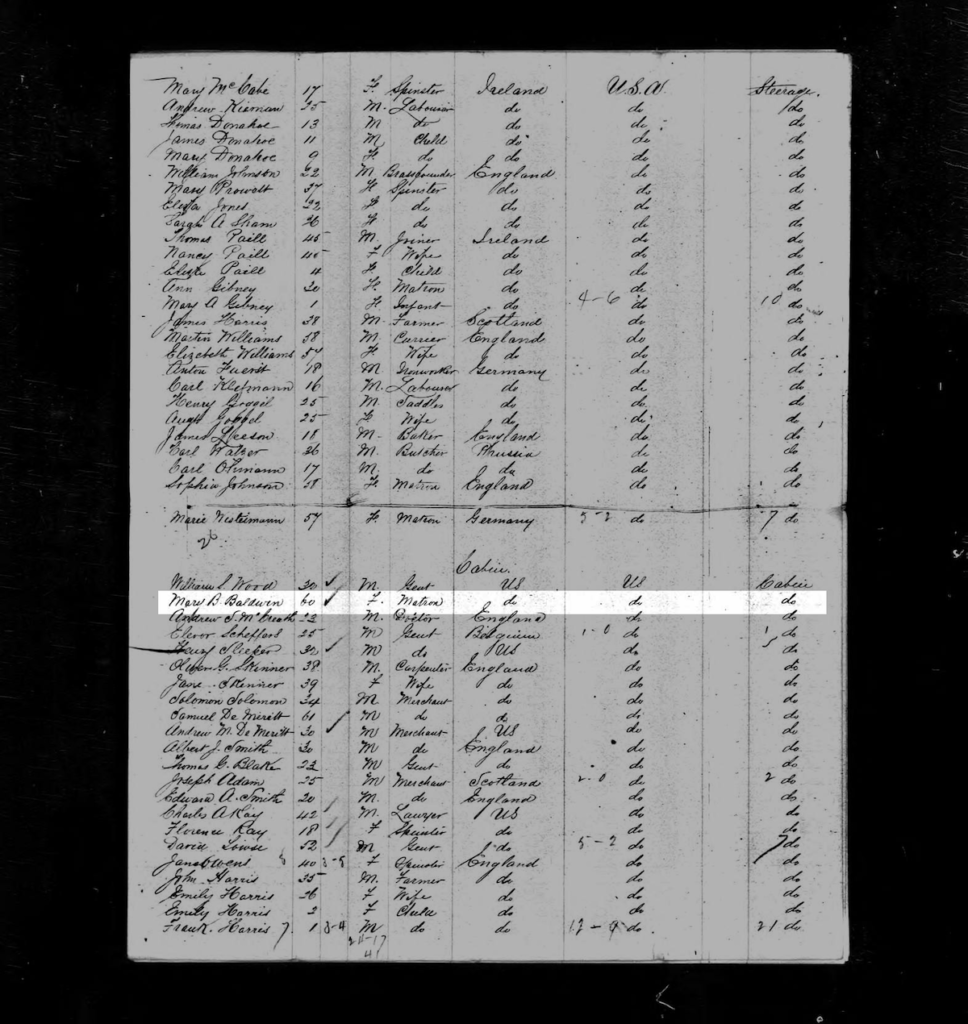After serving in Athens for 33 years, Mary decided to head to Joppa, Syria to rejoin with her sister, Ann, and nephew, John Hay. In Joppa, Mary and Ann lived at “Palm Cottage” in an American colony:
It is beautifully situated near the sea, in the midst of orange gardens, and surrounded by palm trees – hence its name ‘Palm Cottage’.
Mary Briscoe Baldwin (Pitman, 1880, p. 188)
Mary worked with a woman named Miss Arnott, a Scottish woman, to establish a girls’ boarding school using a grant through the Society for Promoting Female Education in the East. However, Mary temporarily lost her eyesight, and once she regained her eyesight, she worked exclusively in her nephew’s all-boys Joppa Mission School, which was a counterpart to Miss Arnott’s all-girls school.
In 1869, John had to go to work in Jerusalem, which meant that the school that he and his mother had established with Mary was unattended and abandoned, with neither the students nor the money to keep going. Mary’s boarding school for girls was unfinished, too, so things were at a bit of a standstill. By the following spring in May 1870, the Joppa Mission School reopened at their Palm Cottage. Mary describes the interior of this school as follows:
For school furniture I had to resort to such materials as were at my disposal. An old double carpenter’s table served instead of desks for the boys to write on; and rough loose boards, placed on kegs of nails, served for benches for the accommodation of twenty of the boys; while the rest followed their own custom of sitting on the floor or ground. The frequent upsets from the slipping of the boards afforded much amusement during the year we had to depend on these unstable seats. By the second year we were enabled to secure proper benches, but the carpenter’s table is still in requisition.
Mary Briscoe Baldwin (Pitman, 1880, p. 205)
Her school started with 13 students and grew to 40 students within 6 weeks. Due to limited funds, they encouraged older students to teach younger ones. This growth expanded the school’s inclusivity to include students from Muslim, Greek, Syrian, Roman, Syrian Protestant, and Jewish households.
The students were aged 6-13, all boys, who were eager to learn. In an effort for them to learn how to read the Bible, Mary taught the students how to read and write in their native Arabic language. Their lessons included alphabet, reading, Psalms of David, the New Testament, Scriptures, arithmetic, geography, Arabic grammar, and music.
Did you know?
Mary was the first American Protestant missionary in Palestine proper, earning a salary of 50 pounds a year.

Did you know?
Joppa (Jaffa), Syria is now Tel Aviv, Israel.

While Mary often explained in these letters that the donated funds went to the school as a whole, she understood that churches and donors wanted a personal connection to their donations, so she would profile a specific student in her responses. The following is an excerpt from a letter that Mary wrote on September 23, 1875, talking about one of her former students whose progress she shared with donors back in America:
Your boy, Hannah Geshen, has left the school, and I have named another boy in his place. Our school has gone on beautifully this year, the daily attendance being from forty-five to fifty. Hannah Geshen came to the Sunday School as usual last Sunday. I asked him what he was doing now. He said that he was working at the carpenter’s trade. I told him I was very glad that he was so well occupied. As soon as I hear from you again I will write, informing you all particulars about the boy I have chosen in Hannah’s place.
Mary Briscoe Baldwin (Pitman, 1880, p. 245)
Fundraising in America
However, Mary needed more money to continue to fund the school. She had her 50-pound annual salary, but she nearly depleted it her personal funds during the Cretan Revolt, so she, once again, headed home to America to fundraise. Shortly after she arrived in America, she had a bad fall coming out of church and fractured her thigh. This injury ultimately made her lame, but even through the pain, she never complained.
I then went to America, partly to visit my native land and kindred, whom I had not seen for twenty-five years, and partly to ask the Foreign Committee to take charge of my work. They declined assuming it at first, but expressed their approbation of it, both by word and deed, making a liberal contribution to it. When I had gone round visiting my friends and relations, I seriously and prayerfully considered what I should do, and was led to go forth in the strength of the Lord, just as I was, a lone female, and ask Christians at large for aid to carry on my school.
Mary Briscoe Baldwin (Pitman, 1880, p. 215)
By the winter of 1872-1873, Mary had raised nearly $2k in America and headed back to Syria on December 11, 1873. Once back in Joppa, she continued to keep in touch with donors back in America. Her letters to these donors indicate that many of them wanted to know of a specific student or group of students who their donations were helping.

This excerpt is particularly insightful because, as she did in Athens with young women, Mary continued to teach Scripture as well as marketable trade skills. So for these boys and young men, she taught them carpentry so that they could provide for themselves and their families. In another letters, she writes about how teaching carpentry is her favorite trade because it was the trade that “our Blessed Saviour Jesus Christ followed.” (Pitman, 1880, p. 246)
Two Jaffa Sisters
Miss Parkman was an American tourist visiting The Holy Land in April 1871 when she connected with Mary and Ann Hay. She described Palm Cottage as almost a New England-style home, made of wood but full of light. She even described Mary and Ann as “very New England looking” women who were “a little stiff at first, though kindly and thawing into cordiality as they talked, as Yankees do.” (Vogel, 1993, p. 96)
It is worth noting Miss Parkman’s observations because by 1871, Mary had been conducting mission work overseas for over 35 years, and it’s important to realize that her life was far from easy abroad. She was in a foreign land, navigating a foreign culture, trying to teach English and Scripture to non-native speakers. During it all, Mary lived modestly, too, so Miss Parkman’s observation that Mary and Ann had the austerity of New England woman is insightful – in other words, their devotion to their mission work had hardened them to the point that their Virginia roots were no longer visible on the surface.
Go to previous section, Holiday in Italy
Go to next section, Death & Legacy
Ancestry.com. New York, U.S., Arriving Passenger and Crew Lists (including Castle Garden and Ellis Island), 1820-1957 [database on-line]. Lehi, UT, USA: Ancestry.com Operations, Inc., 2010.
National Archives and Records Administration (NARA); Washington D.C.; Roll #: 199; Volume #: Roll 199 – 01 Oct 1873-31 Dec 1873
Pitman, E. R. (1880). Mission Life in Greece and Palestine: Memorials of Mary Briscoe Baldwin, Missionary to Athens and Joppa. Cassell, Petter, Galpin & Co.
Vogel, L. I. (1993). To See A Promised Land: Americans and the Holy Land in the Nineteenth Century. The Pennsylvania State University Press.